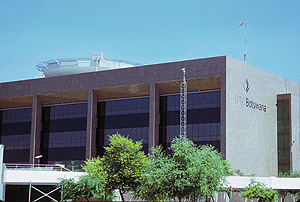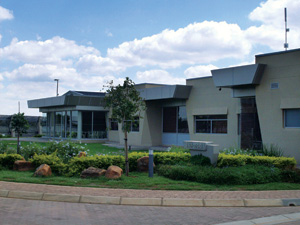The complicated dance between De Beers sightholders and the
London-based brokers who work with them is about to get considerably more
complex with the imminent move of the sights to Gaborone. It is anticipated
that the first full Gaborone sight will take place in January of 2014.
The move will mark the close of a remarkable period of
business-as-usual for De Beers and its sales, marketing and distribution arm,
the Diamond Trading Company (DTC), and a dramatic change in how — and where —
their business is conducted for the foreseeable future. The seismic shift to
Botswana is more than geographic. It’s the essential next step in the southern
African country’s attempt to reinvent itself as a full-service world diamond
center covering all the stages from mining to jewelry manufacturing and sales.
But it will drastically change the industry landscape and dramatically affect
the lives of all who work in diamonds, especially brokers and
sightholders.
CRUCIAL CONTACT
Throughout the diamond industry’s evolution, brokers have
served as some of their clients’ most important and best-informed business
associates. But following World War II, brokers became absolutely essential to
the success — and even survival — of U.S.-based diamond buyers. That is when De Beers
started having trouble with the United States Justice Department and other U.S.
governmental agencies. Criticized at first by the U.S. for refusing to provide
industrial diamonds for the war effort, De Beers was soon being investigated
for its monopolistic activities, which were the very heart of the way it sold
rough diamonds. U.S. antitrust charges were brought against the company in
1945, 1957 and 1974, forcing the company to cease all direct operations in the
U.S., its largest customer at that time.
There was little question that De Beers acted like a
monopoly. At that time, it controlled the sale of 85 percent of the world’s
diamond production and, at the same time, virtually set market prices in
response to fluctuating demand and fluctuating supply. The business was opaque,
one-sided, extremely effective — and profitable. De Beers controlled not only
the amount of goods each client was offered in its box; it also decided on the
types and sizes of goods each box contained, based on its own opinion of each
individual sightholder’s needs.
But, for some U.S. clients with a long history of doing
business with De Beers, the order to cease all U.S. operations was shockingly
abrupt. Around 1973, one diamantaire recalls, he suddenly found his calls to
the DTC being refused. When he finally got a call through, before he could even
speak, he was told, “Do not, under any circumstances, call me again.” At the
same time, De Beers executives could not travel to the U.S. for any reason for
fear of being arrested as agents of a monopoly.
The solution? U.S. sightholders, who could no longer do
business directly with De Beers, were advised to hire London-based diamond
brokers to act as intermediaries. The brokers would represent their clients in
the all-important decision-making process by which De Beers determined what
goods each sightholder would receive. Many of the brokers had worked for De
Beers directly or for DTC, familiarly known as “the syndicate.” They were
intimately familiar with the way the company worked and made good use of this
valuable knowledge in guiding their clients through the ten sights offering
rough diamonds each year.
NEW ERA
Today, antitrust allegations against De Beers have
dissipated, in part because it no longer controls the major part of either the
mining or the marketing of diamonds. In recent years, diamond business has
increasingly shifted to other diamond centers and few current sightholders are
U.S. based. The role of the broker, however, has not diminished. Rather, it has
grown and changed, a reflection of the massive shift in the industry from one
that is supply driven to one that is demand driven.
Mike Aggett, managing director of H. Goldie, a 100-year-old
firm based in London, describes the multifaceted roles of brokers in today’s
diamond business. Aggett is based in the firm’s Antwerp office, in the heart of
that city’s historic diamond district. “The broker’s role has evolved as a
result of the growing rarity of our natural product, the increasing demands of
the ever-more-educated consumer and the development of new markets,” Aggett
explains. The reduced volume of goods supplied by the DTC also reduced its role
as custodian of the diamond supply, but its actions still shape the industry.
For that reason, Aggett says, “H. Goldie places great importance on aligning
its sightholders’ businesses with the strategic vision and goals the DTC has
for the industry.”
Saul Goldberg, president of the New York City firm founded
by and named for his father, William Goldberg, describes the relationship with
his broker, Bonas, as far more than just an intermediary. “There is a strategy
among the DTC to allot the goods. The broker is working on this all year long.
They have to strategize to represent the client, to get the product. Does the
broker position you properly with the DTC? It’s not just buying the rough. The
DTC asks, ‘Are you branding?’ ‘How are you selling your goods?’” Acquiring the
goods is just the first step in the process; the broker is involved with
helping the sightholder position his diamonds in the global marketplace. The
broker and his client are a team, Goldberg adds.
EXPANDING ROLE

|
|
DTC Botswana
|
Brokers such as H. Goldie, Hennig and Bonas — all London
based — have become silent partners as sightholders navigate the ever-changing
nature of the business. Aggett says that with the global production of rough
diamonds forecast to decline, brokers have taken on an active role in helping
their clients secure a regular and sustainable supply of rough. “H. Goldie is
in regular contact with other producers and producer governments to promote and
present their customers’ businesses in a way that crystallizes how they can
become a valued asset to a supplier. This can involve formalizing presentations
on their behalf,” similar to the way brokers have been assisting clients in
their submissions for the DTC’s Supplier of Choice (SOC) program and the latest
DTC requirement, the Contract Proposal Questionnaire (CPQ).
Aggett adds that “In addition to securing supplies and an
upstream focus, many sightholders need assistance and support in forging
downstream relationships.” To that end, the company provides analysis of mining
forecasts and potential future sources of supply to assist its clients in the
development of future business.
The broker, originally just a middleman, is now seen as an
adjunct marketing department. “The brokers have moved from a position of
‘lobbyist’ for their clients to the DTC to a far more professional and
proactive role with a much deeper involvement in all aspects of their
customers’ businesses,” explains Aggett. “This might include, in addition to
their DTC representation, rough sourcing from other producers, marketing and
forging connections with downstream partners for both loose polished and
jewelry products,” all the while never forgetting to “oversee adherence to Best
Practices and general compliance throughout the pipeline.”
GOING TO BOTSWANA
With the shift to Gaborone, brokers are setting up offices
in the capital city and moving personnel there to better position them to
continue to serve their sightholder clients. Aggett himself expects to spend
ten days a month in Botswana and says, “We will shift a part of our
infrastructure to Gaborone in order to have people on the ground who will
liaise with the DTC on a regular basis, arrange finance, exports and many of
the other functions that have historically been carried out from London.”
Hennig, another long-time broker, already has opened an
office in Gaborone that is being headed by Tshebetso Kgatlwane. Diamond
industry veteran Jamie Mordaunt, formerly with De Beers, recently joined Hennig
for the specific purpose of relocating to Botswana to maintain the firm’s
relationship with the DTC team that will likewise relocate to Botswana. A
spokesperson for Hennig notes, ”The move provides exciting opportunities to our
clients beyond the mere change in location of sights. Among these is proximity
to the largest single source of rough diamonds, to other rough suppliers in the
regions and to other business opportunities in Botswana.” In addition, the
company describes the moves as “part of our expansion plans for the
transformation of our Botswana office into a major hub” for diamond business.
The added cost of doing business in Botswana is undisputed
and considerable. Brokers will have to maintain satellite offices and travel
frequently to oversee their operations there. Sightholders, accustomed to
London, will have to become adept at traveling to Gaborone, adding considerable
time, inconvenience and expense to their monthly buying trips. Whether they are coming from New York, Tel Aviv, Mumbai or Antwerp, they
will have to change planes in Johannesburg for the final hop to Gaborone.
THE TRIP JUST GOT LONGER

|
SAFDICO Diamond Technology Park
|
Goldberg foresees a big change in his travels to the sights.
As a sightholder in association with Leo Schachter, Goldberg describes his
trips to the London sights as “a quick hop across the Atlantic. You arrive in
the morning, rest a little, meet with your broker and look at the box. You can
be back home the following evening.” That’s not going to be the case with
travel to Gaborone.
Bonas traces its company’s founding to virtually the moment
diamonds were discovered in South Africa in the 1870s. But this firm with a
very long history has proven to be pretty nimble in responding to changes in
the industry. According to Bonas’ website, the company is involved not only
with mining, trading and purchasing of rough diamonds but also with diamond
polishing, jewelry manufacturing, retailing and consumer marketing. It divides
its business into two distinct areas: DTC Relationship Management and Value
Chain Consulting. While its clients include retailers, governments and banks,
Bonas claims its diamantaire clients produce more than one-quarter of the
world’s polished diamond output. It maintains an office in the new heart of
Botswana’s diamond hub, Diamond Technology Park (DTP) in Gaborone.
Bonas’ website also highlights the variety of challenges
today’s sightholders face, including fragmentation of supply, emergence of
alternative trading centers, upstream and downstream consolidation; impact of
growing consumer markets; overcapacity of production and the increasing role
played by national governments in the industry.
MOVING AHEAD
The move of the entire history and tradition of sights from
London to Gaborone is unprecedented in size and impact. It represents a
remarkable accommodation to the rapid changes in the industry and, most
particularly, to the ability of Botswana — the world’s newest and most
important diamond-producing nation — to secure added value for its most famous
resource. More than any other nation on the African continent, Botswana’s
intelligent and far-sighted leadership has enabled it not only to make the most
of its diamonds, but to see the way to a future that builds upon those diamonds
to assure economic growth and prosperity and provide more and better jobs for
its citizens.
Article from the Rapaport Magazine - July 2012. To subscribe click here.